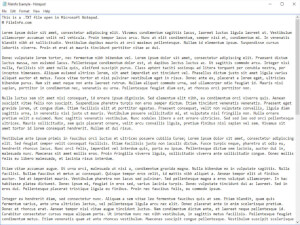Wie erstellt man eine TXT-Datei?
Es gibt mehrere Möglichkeiten:
- Der Editor in Ihrer IDE reicht dafür aus. Die Sache, die Sie sich merken sollten, ist, dass Sie die Datei mit einer Erweiterung speichern wollen, die NICHT .py ist, wenn die Datei keinen Python-Code enthält. Muss die Erweiterung .txt sein? Nicht unbedingt, aber es ist sehr üblich, dass Textdateien diese Erweiterung haben.
- Notepad ist ein Editor, mit dem Sie Textdateien erstellen können. Er befindet sich in "Alle Programme", unter "Zubehör" auf einem Windows-Rechner.
- Es gibt auch andere Editoren, die ebenfalls funktionieren. Achten Sie auf das Format der Datei, die Sie speichern - normalerweise gibt es ein Feld, das Ihnen eine Auswahlmöglichkeit bietet.
- Microsoft Word KANN eine Textdatei erstellen, aber Sie MÜSSEN sie richtig speichern. Sie müssen als "Save as Type" den Typ "Plain Text" (*.txt) wählen. Wenn Sie den Standardtyp verwenden, erhalten Sie eine DOC-Datei. Es reicht in Word NICHT aus, im Fenster "Speichern" einfach den Dateinamen "meineDatei.txt" einzugeben. Wenn der TYP der Datei nicht korrekt eingestellt ist (d. h. auf "Plain Text"), wird eine Datei mit dem Namen "meineDatei.txt.doc" erstellt, die immer noch eine DOC-Datei ist!
- WordPad speichert eine Textdatei, aber auch hier ist der Standardtyp RTF (Rich Text). Dies ist KEINE Textdatei! Versuchen Sie, eine RTF-Datei in Notepad zu laden, und Sie werden alle anderen Daten darin sehen.
Warum brauchen wir TXT-Dateien?
- Sie sind einfacher und schneller zu erstellen.
- Sie sind kleiner, sodass Ihre Zip-Dateien kleiner sind und weniger Platz auf dem System einnehmen.
- Sie sind portabler - ein Rechner mit nahezu jedem Betriebssystem kann sie lesen.
- TAs können Zuweisungen auf Unix-Systemen statt auf Windows-Systemen benoten.
- Sie sind leichter auf Plagiate zu prüfen.
Wie öffnet man eine TXT-Datei?
Wenn keine spezielle Formatierung von der Datei verwendet wird, kann eine Textdatei mit allen Texteditoren geöffnet werden. Eine Textdatei kann z. B. mit dem Programm Notepad in Windows geöffnet werden, mit dem Benutzer auch Textdateien anzeigen und ändern können.
Notepad++ ist ein weiteres Programm, das zum Öffnen von Textdateien verwendet werden kann. Sie müssen es einmal installieren und dann die Option mit Notepad++ bearbeiten wählen, indem Sie mit der rechten Maustaste auf die Datei klicken. Außerdem sind die meisten mobilen Geräte und Webbrowser in der Lage, Textdateien ebenfalls zu öffnen.
Wie konvertiert man TXT-Dateien?
Obwohl es viele Gründe geben kann, Textdateien in andere Formate wie XLSX, XML, HTML, CSV, PDF und mehr zu konvertieren, besteht das Hauptziel darin, das Textdateiformat zu ändern, um sie in einem anderen Dateiformat zu speichern. Die meisten fortgeschrittenen Texteditoren können das, aber einfachere unterstützen in der Regel nur grundlegende Exportformate wie RTF, CSV und TXT; daher sind sie nicht in der Lage, dies zu tun.
Das Programm Notepad++ kann zum Beispiel eine Vielzahl von Dateiformaten speichern, wie KML, HEX, VHD, AU3, SH, BAT, HTML, TXT, NFO, TEX, PLIST, REG, URL, JAVA, XML, PHP, PS, ASM, SQL, CSS, CMD und VGS.
Andere Programme, die zum Konvertieren einer Datei in ein Textformat verwendet werden, können wahrscheinlich mit einigen verschiedenen Arten von Erweiterungen speichern, wie XML, TXT, CSV und RTF. Wenn Sie also eine Datei aus einem bestimmten Programm in das TXT-Format umbenennen möchten, müssen Sie zu der Anwendung zurückgehen, die die ursprüngliche Textdatei erstellt hat.
